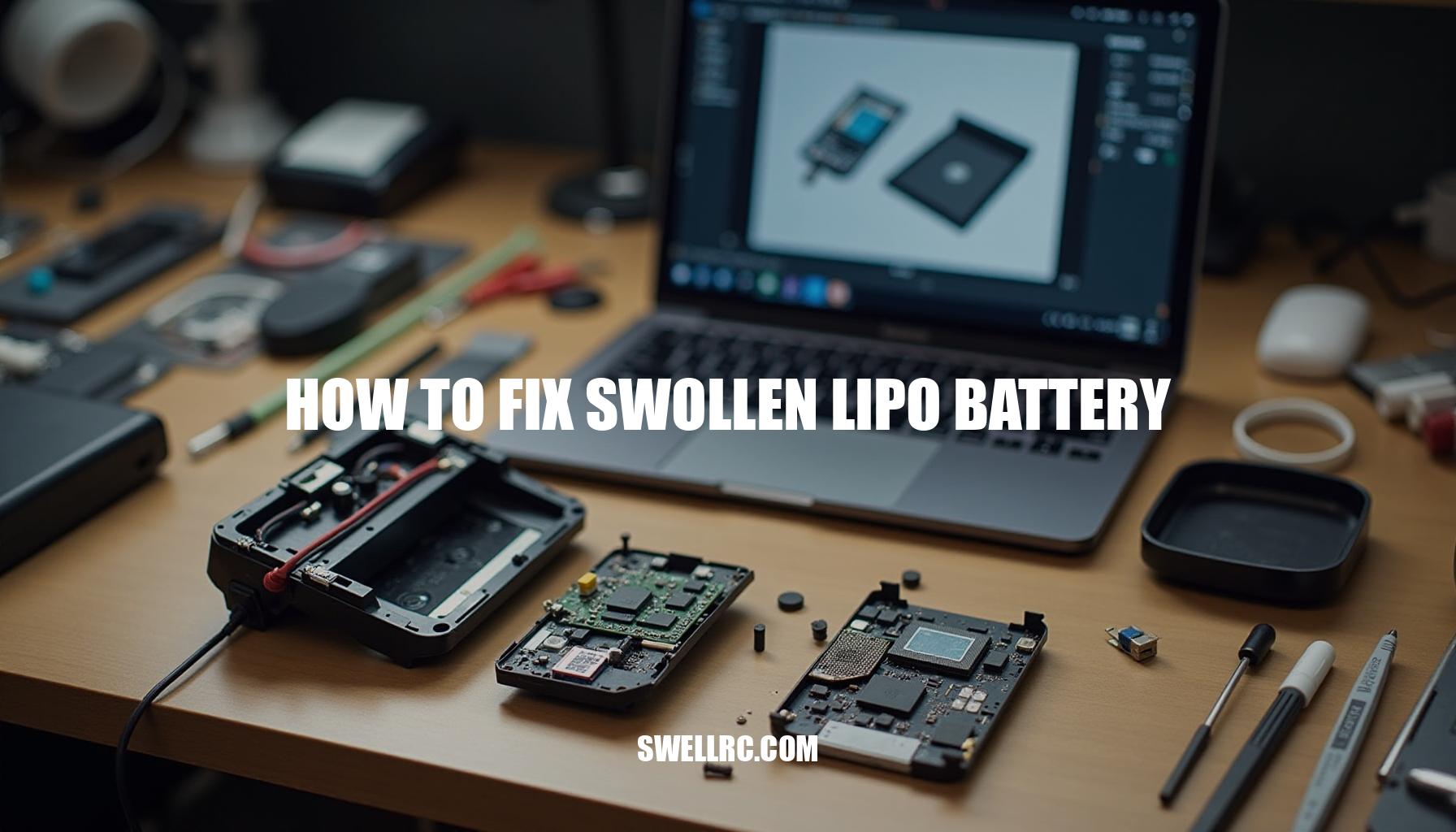How to Fix Swollen LiPo Battery: Expert Guidance and Best Practices
The first time I saw a swollen LiPo, my heart skipped a beat. My trusty quad had just landed a little hot, and when I pulled the pack out, it looked and felt like a marshmallow—soft, bloated, and totally wrong. That moment taught me to develop a deep respect for lithium chemistry and underscored the critical importance of proper LiPo battery care.
After spending hours on research, bench testing, and real-world flying, I discovered how to spot swelling early, handle it safely, and address swollen LiPo repair the right way—spoiler: often the best “repair” is to retire and replace the battery. Equally vital is understanding how to prevent swelling altogether, ensuring your RC battery maintenance routine keeps your drone, quadcopter, or car operating safely and efficiently. We’ll begin by exploring why LiPos swell in the first place—because when you grasp the “why,” knowing the best steps to take in drone battery safety and battery disposal safety naturally falls into place, helping you keep your RC gear flying, driving, and ripping with confidence.
Understanding Why LiPo Batteries Swell and the Science Behind It
Swelling in LiPo batteries occurs when the internal chemistry goes off balance, causing gases to form and puff the pouch much like an overinflated balloon. From my experience on the workbench to the field, I’ve identified three main battery swelling causes: overcharge, overdischarge, and heat exposure. For example, one of my packs puffed after a long session on hot asphalt—not due to abuse but heat stacking on a pack already near its limits.
To understand the broader safety context, check out this detailed resource.
| Cause | What Actually Helps |
|---|---|
| Overcharging or charging too fast (beyond 1C) | Use a quality balance charger, stick to 1C unless the pack specifies higher, always balance charge to avoid cell imbalance. |
| Overdischarging (flying/driving until power sags hard) | Set a conservative low-voltage cutoff and aim to use only 70–80% of capacity to protect the pack. |
| Heat exposure (hot car, no airflow, overly aggressive gearing/props) | Keep packs cool by allowing cooldown between runs, improving airflow, and gearing down or using gentler props. |
| Cell imbalance | Balance charge every session and retire packs that consistently show drifting cells. |
| Physical damage | Retire the pack immediately; never compress or puncture a puffed LiPo pack. |
From personal experience, the first time I noticed “mystery swelling” it was mild but persistent. Battery logs showed repeated high-current spikes under hot weather conditions. By reducing prop pitch and allowing the pack sufficient cooldown time, I was able to maintain healthier packs in the long term.
Safety disclaimer: never puncture, compress, or try to “flatten” a swollen LiPo. The proper goal is safe handling, not forcing it back into shape, ultimately helping to prevent hazardous situations.
Immediate Steps to Take When You Notice Swelling
When dealing with a swollen LiPo battery, immediate LiPo safety is crucial. First, isolate battery by powering down your RC or drone right away and moving the battery to a nonflammable surface such as concrete, tile, or a metal tray away from any flammable materials. Next, conduct a careful swollen LiPo handling inspection by visually checking for severe bulging, heat, unusual odors, or hissing sounds.
If any of these signs are present, treat the battery as high risk and keep it isolated. Then, disconnect power by removing the battery pack from its device or charger without wiggling or squeezing the swollen area. For safe storage, place the pack inside a LiPo-safe bag or a vented metal container, keeping it in a cool and supervised location.
Importantly, do not attempt to charge a puffed pack as this poses a significant hazard. Instead, plan for proper disposal or, if the swelling is borderline, perform a cautious diagnostic. Following these RC battery emergency steps can prevent minor battery issues from escalating into dangerous situations.
For those new to managing charge times or seeking a refresher, maintaining a disciplined charging routine helps ensure the safety of the rest of your battery fleet. More detailed guidance on safe charging practices can be found here: How Long Do I Charge My RC Car Battery?
Diagnostic Techniques: Can a Swollen LiPo Battery Be Saved?
Here’s the hard truth from my LiPo diagnostic tests: “fixing” usually means deciding whether the pack is safe enough for gentle, limited use or should be retired. Minor vs severe swelling is a key factor. Minor puff can sometimes be stabilized; severe swelling almost always requires disposal.
How I check a puffed pack:
- Visual: Slight softness and small bulge vs. misshapen, hard, or creased pouch.
- Temperature: Cool to the touch vs. warm/hot without load.
- Voltage and balance: Use a voltmeter or charger to perform per-cell voltage checks and identify imbalance.
| Voltage/Condition | Action |
|---|---|
| Cells ≥ 3.7V, imbalance ≤ 0.05V, very mild puff | Rest the pack, perform a storage charge in a LiPo bag, and retire from high-amp use. Monitor over multiple cycles. |
| Any cell 3.3–3.7V, puff present, imbalance ≤ 0.08V | Attempt a balance charge at low current in a fire-safe area. If swelling or heat increases, stop and dispose. |
| Any cell < 3.3V or imbalance > 0.1V, visible puff | Do not charge. Dispose safely. |
| Hot, hissing, or strong odor at rest | Emergency isolation and disposal. |
Be mindful of RC charger setup compatibility. Using incorrect settings or adapters can worsen the condition. If you run mixed brands, this guide helps avoid charger pitfalls: https://www.swellrc.com/how-to-charge-non-traxxas-batteries-on-traxxas-charger/.
Bottom line: Safety always trumps restoration. Most puffed LiPos are best retired and replaced before they surprise you mid-run or mid-air. Proper LiPo replacement and cautious balance charge practices reduce risks and prolong your RC adventures.
How to Safely Dispose of and Replace a Swollen LiPo
Responsible disposal protects you and the environment. To ensure environmental safety and safe LiPo disposal, always contact local e-waste or hazardous waste centers; many accept LiPo batteries. Some hobby shops also accept old packs. If required by your facility, use your charger’s discharge or storage mode to bring the pack to a safe level under supervision in a fire-safe area—never leave it unattended.
Before transport, tape exposed terminals to prevent shorts, store the battery in a LiPo-safe storage bag, and carry it inside a nonflammable container to guarantee safe transport.
Saltwater myth vs. reality:
- Myth: Soaking LiPo batteries in saltwater for days “neutralizes” them.
- Reality: This practice is outdated, messy, and can corrode battery leads without fully discharging the cells. Instead, prefer proper discharge modes and certified disposal channels for battery recycling.
| Disposal Do’s | Disposal Don’ts |
|---|---|
| Isolate the battery Tape terminals to prevent shorts Use LiPo-safe storage bags Call your local recycling center Transport batteries carefully |
Puncture or crush packs Incinerate batteries Toss in household trash Soak in saltwater to discharge |
Replacing the pack is the perfect opportunity for a LiPo replacement that improves RC setup performance and reliability. For those upgrading, this comprehensive guide is an excellent starting point. Remember, there’s never regret in retiring a sketchy pack—only regret when you try to squeeze “one more run” from it.
Preventing Future LiPo Swelling: Simple Rules That Actually Work
Maintaining your drone or RC helicopter LiPo batteries effectively requires a combination of disciplined battery maintenance and smart usage habits. Here are some field-tested habits that made my packs last longer and stay flatter, preventing common issues like LiPo swelling.
- Charge smart: Always use balance charging at 1C current unless the manufacturer explicitly approves higher rates. It’s vital to stop charging if a pack warms up or puffs. For drones such as the Tello, adhere strictly to the recommended charging routines.
Useful guides include this Tello charging tutorial and tips on detecting full charge.
- Respect voltage levels: Target using about 70–80% of your battery’s capacity per cycle. Land your drone or heli when cells are approximately 3.5–3.6V under load, and store batteries at a safe LiPo storage voltage between 3.75 and 3.85V per cell to maintain longevity.
- Temperature management: Avoid running or charging batteries while they are hot. This includes not leaving packs in hot cars or direct sunlight. Allow packs to cool sufficiently before recharging, as heat accelerates battery degradation and increases the risk of swelling.
- Right-size your setup: If you notice your packs heating excessively or
Related RC Battery Troubleshooting Insights
Battery health touches every part of your rig’s performance. A sagging pack can mimic mechanical tuning issues, make ESCs thermal, and even shake apart bodies and bumpers.
- If you’re chasing weird handling or durability problems while also seeing voltage sag, inspect the battery first. It may save you a wild goose chase.
- For chassis-related gremlins and protection ideas, I’ve leaned on this guide: https://www.swellrc.com/rc-road-rage-speed-bumpers-troubleshooting/
- If your bashing leaves the shell worse for wear, pair battery care with smart body fixes: https://www.swellrc.com/how-to-repair-rc-car-body/
The big lesson from comparing multiple setups: electrical health and mechanical health are a team sport. Treat the pack as the heart of the system, and everything else runs better. By combining RC troubleshooting with integrated maintenance strategies, you can effectively tackle battery performance issues and enhance your rig’s overall longevity and responsiveness.
Conclusion: What Fixing a Swollen LiPo Battery Taught Me
Owning LiPos taught me to balance thrill with responsibility. Respect the chemistry, and it’ll reward you with consistent power and longer life. Ignore it, and swelling is your early warning siren.
Following LiPo battery best practices is essential for responsible RC use, ensuring both safety and performance. Here are some key points of swollen LiPo guidance to keep in mind:
- Swelling is a safety signal—don’t ignore it.
- Mild puff may be managed; severe puff means retire and dispose.
- Balance charge, manage heat, and store at 3.75–3.85V per cell.
- Use the right charger settings and keep an eye on cell balance.
- When in doubt, replace the pack—your gear (and garage) are worth it.
Adhering to these tips enhances your RC safety and aligns with best practices for prevention and disposal of LiPo batteries. If you came here wondering how to fix swollen LiPo battery problems, I hope you leave with clarity, confidence, and a renewed respect for good battery habits. Treat battery care as a badge of true RC mastery—and enjoy every clean run and smooth flight that follows.
Frequently Asked Questions
- What causes a LiPo battery to swell?
Gas buildup inside the pouch from chemical stress—usually due to overcharging, overdischarging, high temperature, cell imbalance, or physical damage. Heat and repeated high-current spikes are common triggers. - Can a swollen LiPo battery be fixed or repaired?
Not in the literal sense. Mild puff can sometimes be stabilized and used gently after careful checks, but significant swelling should be retired and disposed of safely. Do not puncture or compress the pack. - Is it safe to use a puffed LiPo battery?
Only if swelling is very mild, cells are well-balanced, and temperatures remain normal—then consider low-stress use at your own risk. Any severe swelling, heat, odor, or imbalance means stop using and dispose. - What should I do if my LiPo battery starts swelling during charging?
Stop the charge immediately, move the pack to a nonflammable surface, isolate it in a LiPo-safe bag or metal container, and monitor. Do not attempt to continue charging; plan for disposal if swelling persists. - How can I safely dispose of swollen LiPo batteries?
Use local e-waste or hazardous waste programs. Tape terminals, store in a LiPo bag, and transport in a nonflammable container. Avoid the saltwater soak method; use charger discharge/storage modes only if required and supervised. - How do I prevent LiPo batteries from swelling in the future?
Balance charge at appropriate rates, avoid deep discharges, manage heat, store at 3.75–3.85V per cell, use the right props/gearing, and retire packs that won’t stay balanced.



